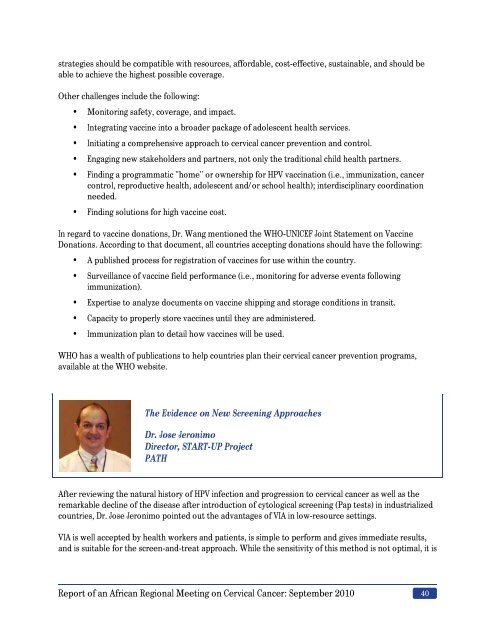Download file, English (1 MB PDF) - RHO
Download file, English (1 MB PDF) - RHO
Download file, English (1 MB PDF) - RHO
Create successful ePaper yourself
Turn your PDF publications into a flip-book with our unique Google optimized e-Paper software.
strategies should be compatible with resources, affordable, cost-effective, sustainable, and should be<br />
able to achieve the highest possible coverage.<br />
Other challenges include the following:<br />
• Monitoring safety, coverage, and impact.<br />
• Integrating vaccine into a broader package of adolescent health services.<br />
• Initiating a comprehensive approach to cervical cancer prevention and control.<br />
• Engaging new stakeholders and partners, not only the traditional child health partners.<br />
• Finding a programmatic "home" or ownership for HPV vaccination (i.e., immunization, cancer<br />
control, reproductive health, adolescent and/or school health); interdisciplinary coordination<br />
needed.<br />
• Finding solutions for high vaccine cost.<br />
In regard to vaccine donations, Dr. Wang mentioned the WHO-UNICEF Joint Statement on Vaccine<br />
Donations. According to that document, all countries accepting donations should have the following:<br />
• A published process for registration of vaccines for use within the country.<br />
• Surveillance of vaccine field performance (i.e., monitoring for adverse events following<br />
immunization).<br />
• Expertise to analyze documents on vaccine shipping and storage conditions in transit.<br />
• Capacity to properly store vaccines until they are administered.<br />
• Immunization plan to detail how vaccines will be used.<br />
WHO has a wealth of publications to help countries plan their cervical cancer prevention programs,<br />
available at the WHO website.<br />
The Evidence on New Screening Approaches<br />
Dr. Jose Jeronimo<br />
Director, START-UP Project<br />
PATH<br />
After reviewing the natural history of HPV infection and progression to cervical cancer as well as the<br />
remarkable decline of the disease after introduction of cytological screening (Pap tests) in industrialized<br />
countries, Dr. Jose Jeronimo pointed out the advantages of VIA in low-resource settings.<br />
VIA is well accepted by health workers and patients, is simple to perform and gives immediate results,<br />
and is suitable for the screen-and-treat approach. While the sensitivity of this method is not optimal, it is<br />
Report of an African Regional Meeting on Cervical Cancer: September 2010 40
















